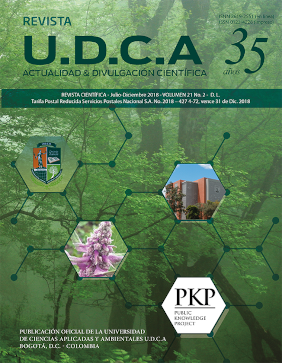Identificación molecular y registro de Aphelenchoides spp. en cultivos comerciales de Hydrangea en Antioquia, Colombia
Molecular identification and report of Aphelenchoides spp. in commercial crops of Hydrangea in Antioquia, Colombia
Contenido principal del artículo
Resumen
El cultivo comercial de hortensias para flor de exportación ocupa un renglón importante en el sector económico del oriente antioqueño, por ser fuente de empleo y de desarrollo en la zona. La hortensia (Hydrangea macrophylla) es afectada por numerosos organismos fitopatógenos, entre ellos, nematodos del género Aphelenchoides, los que ocasionan, en el follaje, lesiones necróticas angulares, malformación de flor, enanismo y un daño indirecto en la tasa fotosintética, demeritando los parámetros de calidad para exportación. El objetivo de este estudio fue identificar, molecularmente, las especies del nematodo Aphelenchoides asociadas al cultivo de hortensias de color, en los municipios de Medellín (Santa Elena), La Ceja y Rionegro, siendo este el primer reporte para Colombia, de las especies de este género. Para la ejecución del estudio, se realizaron 10 muestreos en cultivos comerciales, distribuidos entre los tres municipios mencionados. Los nematodos extraídos, se sometieron a pruebas basadas en el análisis de ADN, haciendo uso del marcador ribosomal 18S. Los análisis filogenéticos practicados mostraron la presencia de la especie Aphelenchoides ritzemabosi en cultivos de hortensias, del corregimiento de Santa Elena y, de A. fragarie, en los municipios de La Ceja y Rionegro.
Palabras clave:
Descargas
Datos de publicación
Perfil evaluadores/as N/D
Declaraciones de autoría
- Sociedad académica
- Universidad de Ciencias Aplicadas UDCA
- Editorial
- Universidad de Ciencias Aplicadas y Ambientales U.D.C.A
Detalles del artículo
Referencias (VER)
BHADURY, P.; AUSTEN, M.; BILTON, D.; LAMBSHEAD, P.; ROGERS, A.; SMERDON, G. 2006. Development and evaluation of a DNA - barcoding approach for the rapid identification of nematodes. Inter Research Marine Ecology Progress series. 320:1-9. https://doi.org/10.3354/meps320001
BUONICONTRO, D.; ROBERTS, D.; OLIVEIRA, C.; BLOK, V.; NEILSON, R.; OLIVEIRA, R. 2018. A rapid diagnostic for detection of Aphelenchoides besseyi and A. fujianensis based on real-time PCR. Plant Disease, 102(3):519-526. https://doi.org/10.1094/PDIS-08-17-1160-RE
CHAVES-BARRANTES, N.; ARAYA-FERNÁNDEZ, C. 2014. Distribución espacial del amachamiento del frijol (Aphelenchoides besseyi Christie) en campo. Agronomía Mesoamericana. 25(1):13-21. https://doi.org/10.15517/am.v25i1.14186
DE JESUS, D.; OLIVEIRA, C.; BALBINO, H.; MACKENZIE, K.; NEILSON, R.; PRIOR, T.; OLIVEIRA, R. 2016. Morphological and molecular characterisation of Aphelenchoides besseyi and A. fujianensis (Nematoda: Aphelenchoididae) from rice and forage grass seeds in Brazil. Nematology. 18(3):337-356. https://doi.org/10.1163/15685411-00002962
EPPO. 2017. PM 3/83 (1) Fragaria plants for planting - inspection of places of production. Bulletin OEPP/EPPO. Bulletin. 43:471-495.
ESCUER, M.; BELLO, A. 2000. Nematodos del género Aphelenchoides de interés fitopatológico y su distribución en España. Bol. San. Veg. Plagas. 26:47-63.
GOLHASAN, B.; HEYDARI, R.; ESMAEILI, M.; MIRAEIZ, E. 2017. Description of Aphelenchoides macrospica n. sp. (Nematoda: Aphelenchoididae) from Northwestern Iran. J. Nematology. 49(1):67-76. http://doi.org/10.21307/jofnem-2017-046
GUÉRIN, V. 2002. Hydrangea: acquisitions nouvelles et applications. Un Point sur. - INRA. Paris, FRA: INRA Editions, 133p. https://prodinra.inra.fr/record/61858
HOYOS-CARVAJAL, L.; MOYA, J. 2010. Nematodos asociados con cultivos de arroz en Huila y Tolima. Agronomía Colombiana. 28(3):577-579.
IPPC. 2016. Annex to ISPM 27 - Aphelenchoides besseyi, A. fragariae and A. ritzemabosi (2006‐025). Disponible desde Internet en: https://www.ippc.int/en/publications/83447/ (con acceso el 1/09/2016).
MOR, M; SPIEGEL, Y. 1993. Infection of Narcissus roots by Aphelenchoides subtenuis. J. Nematology. 25:476-479.
ROJAS, G. 2014. Antioquia es un jardín que florece todo el año. El Mundo. Disponible desde Internet en: http://www.elmundo.com/portal/resultados/detalles/?idx=241227 (con acceso el 20/04/2016).
RYBARCZYK-MYDLOWSKA, K.; MOOYMAN, P.; VAN MEGEN, H.; VAN DEN ELSEN, S.; VERVOORT, M.; VEENHUIZEN, P.; VAN DOORN, J.; DEES, R.; KARSSEN, G.; BAKKER, J.; HELDER, H. 2012. Small subunit ribosomal DNA-based phylogenetic analysis of foliar nematodes (Aphelenchoides spp.) and their quantitative detection in complex DNA backgrounds. Phytopathology. 102:1153-1160. https://doi.org/10.1094/PHYTO-05-12-0114-R
SÁNCHEZ-MONGE, A.; FLORES, L.; SALAZAR, L.; HOCKLAND, S.; BERT, W. 2015. An updated list of the plants associated with plant-parasitic Aphelenchoides (Nematoda: Aphelenchoididae) and its implications for plant-parasitism within this genus. Zootaxa. 4013(2):207-224. http://dx.doi.org/10.11646/zootaxa.4013.2.3
SÁNCHEZ-MONGE, A.; JANSSEN, T.; FANG, Y.; COUVREUR, M.; KARSSEN, G.; BERT, W. 2017. mtCOI successfully diagnoses the four main plant-parasitic Aphelenchoides species (Nematoda: Aphelenchoididae) and supports a multiple origin of plant-parasitism in this paraphyletic genus. European J. Plant Pathology. 148(4):853-866. https://doi.org/10.1007/s10658-016-1141-1
SHURTLEFF, M.; AVERRE III, C. 2000. Diagnosing plant diseases caused by nematodes. APS Press. 189p.
WEAKLEY, A.S. 2015. Flora of the Southern and Mid-Atlantic States. Working draft of 21 May 2015. Univ. of North Carolina Herbarium (NCU), Chapel Hill. Disponible desde Internet en: http://www.herbarium.unc.edu/flora.htm (con acceso el 1/09/2016).
YEATES, G. 1999. Effects of plants on nematode community structure. Ann. Rev. Phytopathol. 37(1):127-149. https://doi.org/10.1146/annurev.phyto.37.1.127







